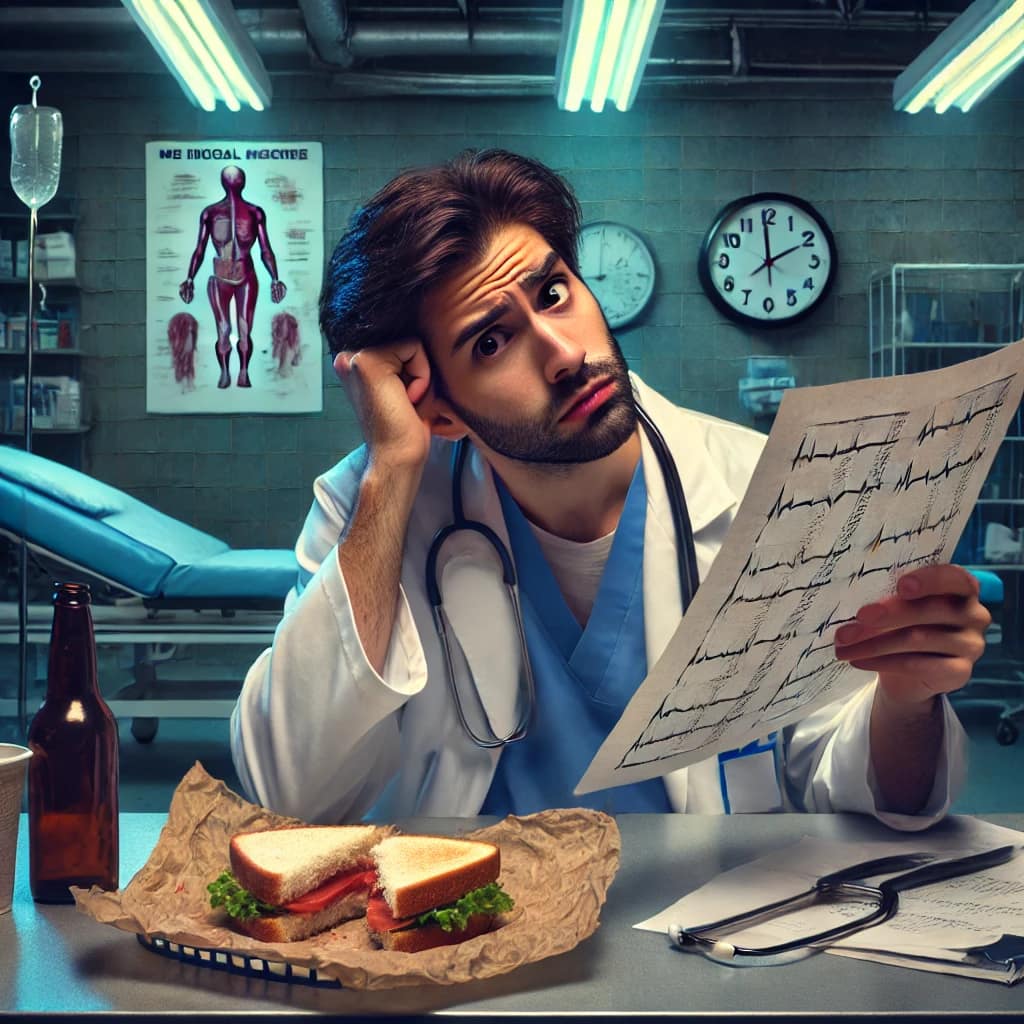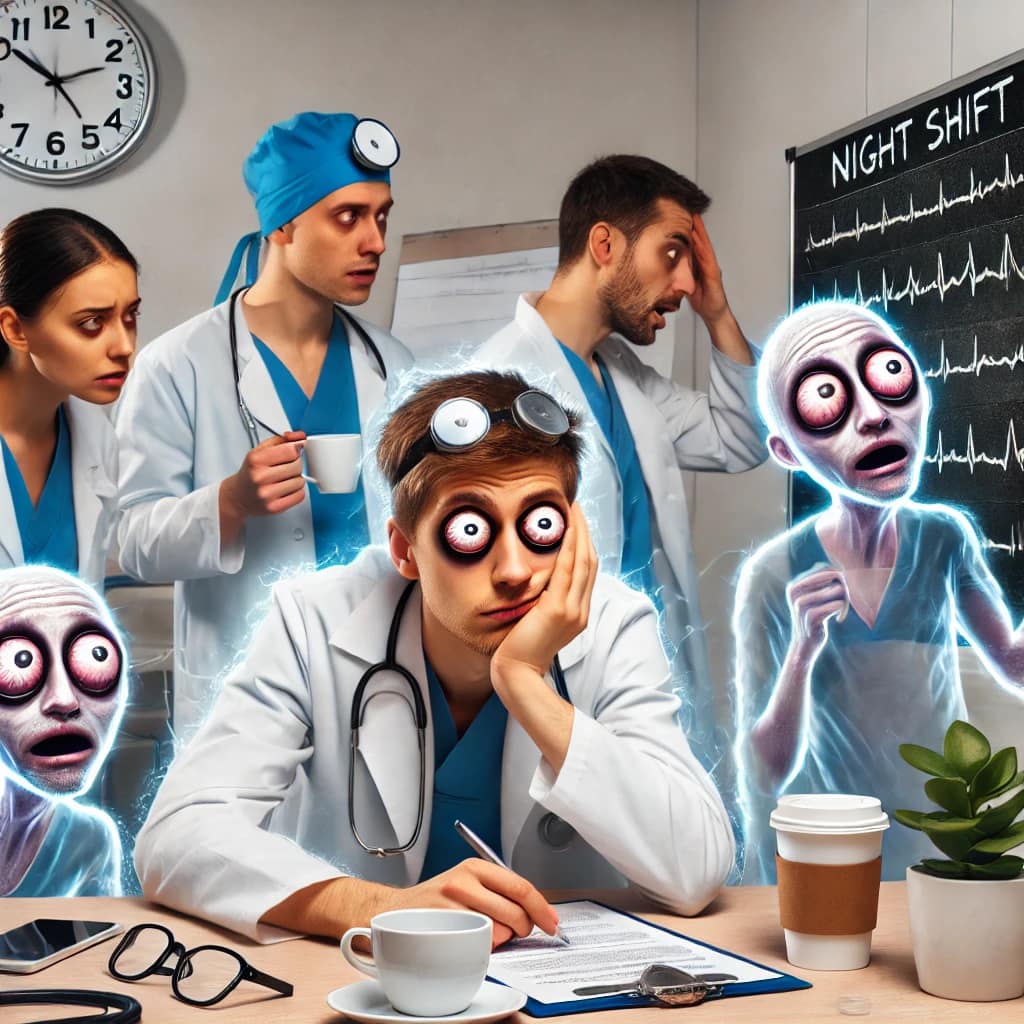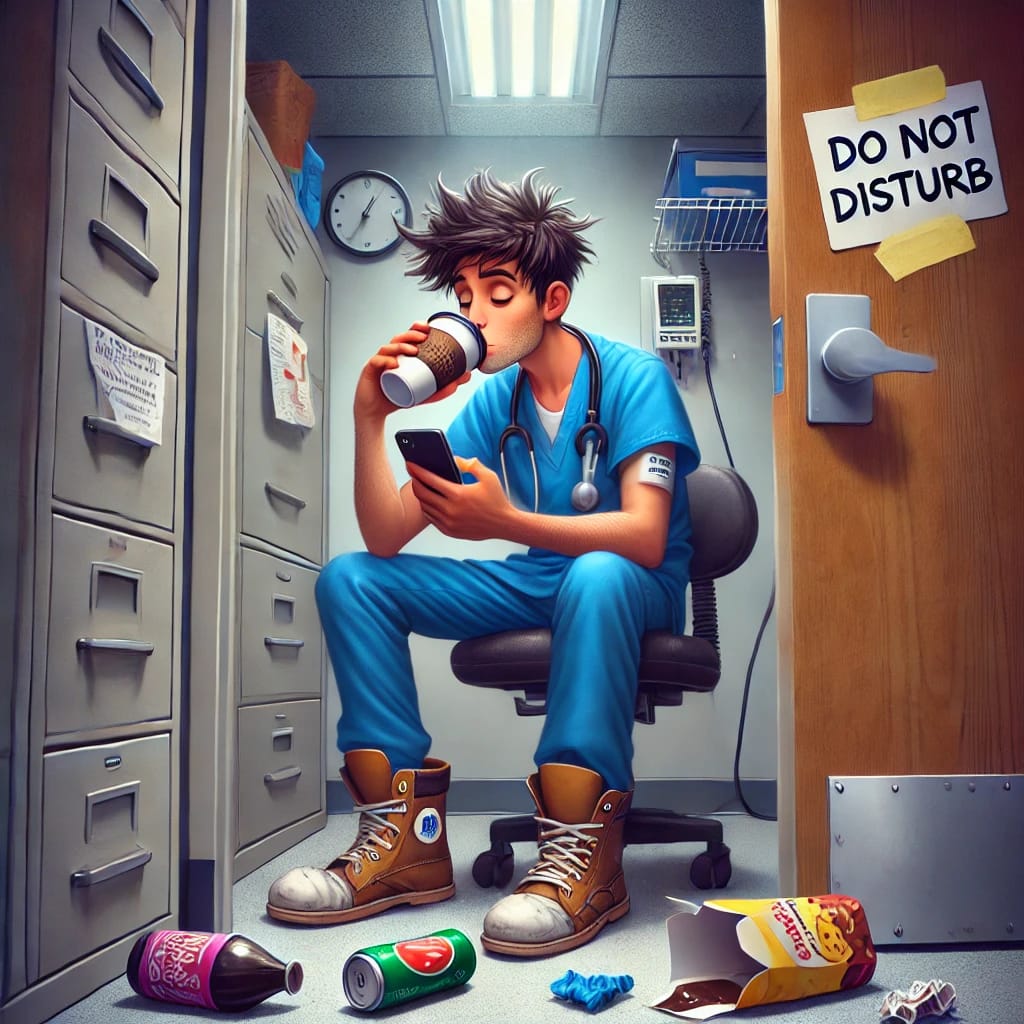They say laughter is the best medicine, which is great—because at this point, most of us doctors are too tired to prescribe anything else correctly.
In a world where being a sleepy doctor is practically part of the job description, doctor fatigue has evolved from a mild inconvenience to a full-blown occupational hazard. Whether you’re on your seventh cup of coffee or wondering if you’ve already given that patient morphine (twice), the reality of night shift doctor life and doctor burnout is one no textbook prepares you for. This article pulls the curtain back on what it’s really like to practice medicine when your eyelids weigh more than your stethoscope—and yes, there’s sarcasm involved.
Table of Contents
The Diagnosis They Forgot to Teach in Med School
Spoiler Alert—It’s Called “Doctor Fatigue” and It’s Not in the ICD-10
They taught us to detect every obscure symptom, to never miss a diagnosis—even the rarest ones. But somehow, doctor fatigue, the most prevalent and corrosive condition among healthcare professionals, never made it into the curriculum.
Doctor fatigue isn’t just physical exhaustion. It’s the kind of soul-deep depletion that sets in when you’ve been awake for 27 hours and still have five patients to see before you even think about peeing. It’s the sleepy doctor nodding along during a family meeting while fantasizing about quitting and becoming a barista.
You don’t learn about doctor fatigue in lectures. You live it—in the call room where your dreams smell like antiseptic and regret. In the sterile silence between codes, when your brain is fried but you’re still expected to “show empathy.”
They trained us to diagnose others.
But no one told us that the most dangerous illness would be our own:
Doctor fatigue with a side of imposter syndrome and a garnish of burnout.
You won’t find it listed in the ICD-10.
But you’ll see it etched into the faces of night shift doctors and ER staff running on caffeine and sarcasm.
You’ll feel it in the sigh that escapes after your fourth cup of coffee and zero acknowledgment.
This is the diagnosis we all carry—silently, professionally.
But now it’s time we name it: Doctor fatigue.

Yawning Through Intubation
(Because nothing says “well-rested” like RSI at sunrise)
There’s a specific type of doctor fatigue that hits different at 5:47 AM. It’s the moment your body is physically performing an intubation, but your soul is curled up in the fetal position under the anesthesia cart.
You’re not tired—you’ve transcended tired.
You’re functioning purely on caffeine, spite, and institutional guilt.
As a sleepy doctor, you’ve mastered the art of sterile yawning. Head tilted back, mouth wide open—your intern thinks you’re demonstrating airway positioning. You’re not. You’re mourning the REM cycle that never was.
The patient’s saturations are fine.
The airway’s secured.
But your brain is three code blues and one ICU meltdown behind schedule.
You wonder—if you pass out mid-procedure, can you bill for it?
Asking for a friend. And by friend, we mean your dead-eyed reflection in the OR glass.
Somewhere, there’s a podcast preaching “early to bed, early to rise” like doctors aren’t on a full moon cycle with bonus night shifts. Those people have never yawned through an intubation, while a nurse casually discusses weekend plans next to you like your soul isn’t evaporating into the HEPA filter.
Doctor fatigue doesn’t ask for permission.
It just shows up—mid-suction, mid-sentence, mid-scream (internally, of course).
You can’t treat it with a venti. You can’t even log it in the electronic chart without falling asleep mid-click.
But you sure as hell can live it… one glazed-over airway at a time.
Charting While Dissociating
(“Was I here for this? Did I even intubate this man?”)
There’s something almost spiritual about staring at an electronic health record at 3:12 AM and wondering if you actually did what you’re trying to document—or if you simply dreamed it while blinking too slowly.
Doctor fatigue turns documentation into a surrealist art form.
You’re typing, sure, but your mind is floating somewhere above the hospital, watching yourself hover over a keyboard like a tired ghost whispering clinical notes into the void.
Vitals? Stable.
Assessment? Unclear.
Plan? “Try not to cry.”
As a certified sleepy doctor, your SOAP note starts looking like a cry for help. You write “patient appears comfortable” while envy eats you alive. Because they’re asleep. And you? You’re one typo away from admitting yourself.
You try to focus, but your hands feel like gloves full of soup.
You reread the same sentence six times: “The patient is a…”
Is a what? A goat? A figment of your imagination?
This is not burnout.
This is doctor fatigue in its purest, most bureaucratic form.
Hallucinating During Handover
(“Was the potassium real, or did I dream it?”)
Handover: that sacred ritual where you pretend to care deeply about what’s about to ruin someone else’s day.
You gather your thoughts (what’s left of them), take a deep breath, and begin:
“Bed 5 has… um… lungs?”
Your colleague nods politely. They don’t care.
They’re also sleepy doctors, riding the same nightmare carousel with the grace of a giraffe on a balance beam.
Mid-sentence, you forget your own name.
You make up words like “neurotastically stable” and just hope no one notices.
You pause dramatically, trying to remember if that potassium of 2.7 was yesterday’s patient or a fever dream you had during the ten-minute nap you took between elevator rides.
At one point, you hear yourself say,
“Labs pending, but we’re cautiously optimistic.”
About what? The survival of your frontal lobe?
There’s no dignity in this. Just two exhausted professionals trying not to collapse before the code pager goes off again.

Code Blue, But It’s My Brain
(Paging all neurons. We’re losing higher function fast.)
Somewhere between your third back-to-back shift and your 19th instant coffee, it happens.
Not to the patient—oh no—they’re fine.
It’s your brain that flatlines.
You stand there, stethoscope around your neck like a noose made of duty, trying to remember if the thing you’re holding is a reflex hammer or a penlight. Spoiler: it’s your pager. And it’s angry.
Doctor fatigue doesn’t creep in.
It crashes through the door, spills your cold coffee, and sits on your chest like an emotionally unavailable ex.
You try to recall ACLS algorithms, but the only letters in your mind are “Zzzz.”
You blink at the defib machine and wonder if you can use it on yourself for a quick reset.
Not for cardiac arrest—just existential crisis.
Your body is in autopilot. Your soul is buffering.
A sleepy doctor with no RAM left, performing like a med school-trained zombie fueled by sarcasm and cafeteria sugar.
This isn’t burnout. This is spiritual vaporization.
This is night shift doctor life, where your EEG would look like a dial tone and your dopamine is on sabbatical.
And when someone says “Code Blue,” you nod and whisper:
“Same.”
Darkness Visible: The Soul of a Night Shift Doctor
There’s a silence that falls over the hospital at 4:17 AM.
Not peace—never peace.
Just the kind of quiet where the fluorescent lights hum louder than your will to live, and you start bargaining with the universe for just one unbroken hour of REM.
This is the underworld of doctor fatigue.
A purgatory built on decaf, code charts, and the smell of surgical masks that haven’t been changed since the Bush administration.
Your thoughts are molasses.
Your emotions? Pickled in cortisol.
You’re a sleepy doctor, clinically alive but emotionally embalmed, performing medicine like a haunted marionette in Danskos.
You pace empty corridors not to check on patients, but to convince your legs they still exist.
You lean against the OR wall, eyes glazed, contemplating the life choices that led you to this moment—like you’re the tragic protagonist in a Kafka novel written by an intern.
Somewhere, a machine beeps.
You don’t even flinch anymore.
Just another lullaby in the eternal insomnia of doctor burnout.
You could cry, but you’re too dehydrated.
You could scream, but you already did… internally, during rounds, when someone asked, “Why didn’t you go into dermatology?”
The truth is:
This isn’t just fatigue.
This is a ritual sacrifice to the gods of healthcare, and you’re the lamb in scrubs.

Let’s be honest — doctor fatigue doesn’t just vanish with a 5-minute sit-down. This air compression leg massager is like having a personal spa in the call room (minus the candles and shame). Designed to improve circulation, reduce swelling, and soothe the calves that carried you through back-to-back shifts — it’s self-care, upgraded.
Because no one deserves this more than the humans who run on caffeine and chart notes.
Survival Tips That Won’t Get You Fired or Institutionalized
- Embrace the Delusion.
If your badge still opens doors and nobody’s called security, you’re doing fine.
Being a sleepy doctor doesn’t mean you’re incompetent—it means you’ve transcended consciousness. That’s practically a superpower. - Befriend the Night Janitor.
They know things. They’ve seen things. And most importantly, they won’t judge you for talking to the IV pole like it’s your therapist. - Nap Like a Ninja.
Ten minutes in the supply closet? That’s not slacking. That’s tactical resuscitation.
Doctor fatigue calls for creative sleep solutions. Linen cart? Break room floor? Improvise. Adapt. Hibernate. - Document With Vengeance.
If you’re going down, at least go down with airtight notes. Preferably timestamped and passive-aggressive. Bonus points if you sneak in a haiku about exhaustion between SOAP sections. - Know When to Vanish.
Not from the hospital. From the break room gossip. From the seventh “Can you just take a quick look?”
From the fifth year resident who still thinks Monster is a breakfast food.
Disengage. Recharge. Reappear sassier. - Eat the Cookie.
The one you found in your coat pocket. From last week.
It’s not about hunger—it’s about hope. - Laugh. Darkly. Often.
With colleagues, not at patients (unless it’s a shared meme).
Laughter doesn’t cure doctor burnout, but it slaps a glittery sticker on the emotional bruises.
The Night Shift Olympics
There’s no official torch, but if there were, it would probably be a half-melted headlamp clutched by a sleepy doctor with one coffee in hand and another IV’d into their soul. Welcome to the Night Shift Olympics—where doctor fatigue is not a condition, it’s a competition.
The events?
100-meter dash to the code blue. Bonus points if you forgot your stethoscope and arrive wheezing louder than the patient.
Synchronized sighing in the break room. Judges deduct points for silence.
Freestyle charting under fluorescent lights while your brain begs for REM.
And let’s not forget “find a place to collapse without leaving a butt-print on the clean linens”—the unofficial finale.
We train all year. We get no medals. Just under-eye bags deep enough to qualify as storage lockers and a talent for crying internally while smiling externally. Every time the hospital lights dim and the chaos begins, we suit up—not like athletes—but like gladiators with caffeine and sarcasm as our only armor.
Because doctor fatigue isn’t a bug in the system—it is the system.
The Secret Language of Sleep-Deprived Doctors
You haven’t truly known doctor fatigue until you’ve conversed fluently in fragmented sighs, wild eye contact, and Morse-code-level eyebrow raises. We don’t speak—there’s no time. A yawn, a raised cup of burnt vending machine coffee, and the occasional whispered “you alive?” form our sacred dialect.
When someone mutters, “Was that today’s Tuesday or next week’s?” and you understand them instantly—that’s real connection. Sleepy doctors operate in a realm beyond language. We communicate through half-smiles and shared trauma. We know that if you put your head down on the desk for “just five minutes,” you’re gone for the rest of your shift or until someone throws a suture kit at your back.
This isn’t a job. It’s a linguistic survival game. One where the prize is staying upright long enough to fake functionality—and maybe, just maybe, form a full sentence.

One Last Confession from the Call Room
There was a night—I couldn’t tell you which one, they all blur—when I woke up fully dressed, surgical mask on, clutching a banana like a pager. No idea how long I’d been out. The monitor was beeping, my back hurt from the chair, and someone had drawn a mustache on my N95. I laughed. Not because it was funny, but because I was two minutes away from either crying or resuscitating the water cooler. Maybe both.
This is doctor fatigue. Raw, absurd, and stitched together with gallows humor and grit. If you’re reading this during a night shift: hydrate, blink twice to stay awake, and remember—there’s no gold medal for surviving this madness, but hell, we deserve one.
Join the Resistance.
If you’ve ever fallen asleep charting or mistaken an OR scrub for your blanket, you’re among friends. Drop your own confession below (anonymity respected—this isn’t HR). Let’s form a support group. I’ll bring the tequila and sarcasm. You just show up semi-conscious.
And hey—follow PropofLOL for more medically-induced madness. We’re funny, exhausted, and definitely not your wellness coach.
